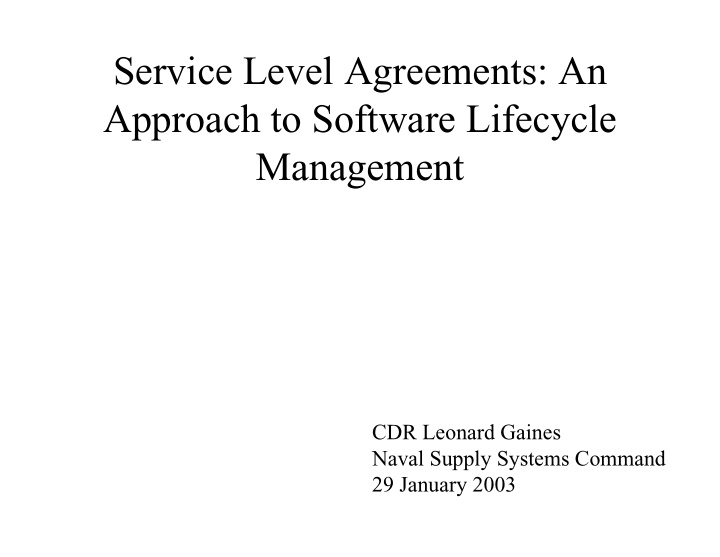



Service Level Agreements: An Approach to Software Lifecycle Management CDR Leonard Gaines Naval Supply Systems Command 29 January 2003
Definition • Definition: A SLA is an agreement between a provider of services and a customer that defines a level of performance or a quality of service. • SLAs define in measurable terms the service to be performed, the level of service that is acceptable, and the means to determine if the service is being provided at the agreed upon levels.
SLA Development • Define the problem • Develop a team • Review current services • Determine requirements • Start SLA development • Determine SLM
SLA Development • Negotiate the services • Determine performance thresholds • Agree on escalation procedures • Establish penalties and/or incentives • Document the SLA • Review and refine over time.
Requirements Analysis • The SLA development process better defines requirements by focusing on quantitative metrics • SLAs facilitate communication • Development includes multiple perspectives including process owners, users, developers, and service providers • Developing the SLAs identifies constraints on the project in terms of personnel, resources, funds, technical capability, and time.
Design • Quality metrics ensures developers are focusing on quality early in the development process • Realistic quantifiable requirements can be used to determine architecture and design. Allows analysis, risk assessment and trade offs. • Availability constraints may drive code reuse, complexity analysis, and better testing/simulation. Allows analysis, risk assessment and trade offs. • SLA may drive user-centric view of availability
Program Management • Focuses management attention on SLAs • Cost-Benefit analysis • SLAs drive monitoring, trend analysis and capacity management • Maintainability thresholds promote accurate configuration management, better documentation, more efficient problem resolution procedures, better backup and disaster recovery plans, and better integrity
SLA Benefits • Quality is something that must be planned • Software quality cannot be measured without proper monitoring • Ensures both parties understand the services to be provided and the quality expected • SLAs set user expectations through defined performance levels • SLAs help drive the managerial oversight to ensure that quality processes are adopted and adhered to
SLA Challenges • Must have a well defined and knowledgeable SLM organization with the authority to manage the SLAs. NMCI does not have this. • PMs are Functional experts with little IT skills. PMs are too willing to accept contractor provided SLAs. The PMs are often forced to rely on contractors for technical support • Complex heterogeneous, distributed systems makes end-to-end SLAs are very difficult to write and enforce
SLA Challenges • Contracting personnel and management must be willing to enforce the SLA penalties • Difficult to define services and service levels to a litigious level • Costly in terms of manpower to develop, perform benchmark analysis and verify compliance • Determining meaningful and measurable performance metrics • Establishing realistic expectations
Conclusion • SLAs are difficult to construct, but they are crucial to quality management. Without SLAs quality assurance cannot happen.
Recommend
More recommend